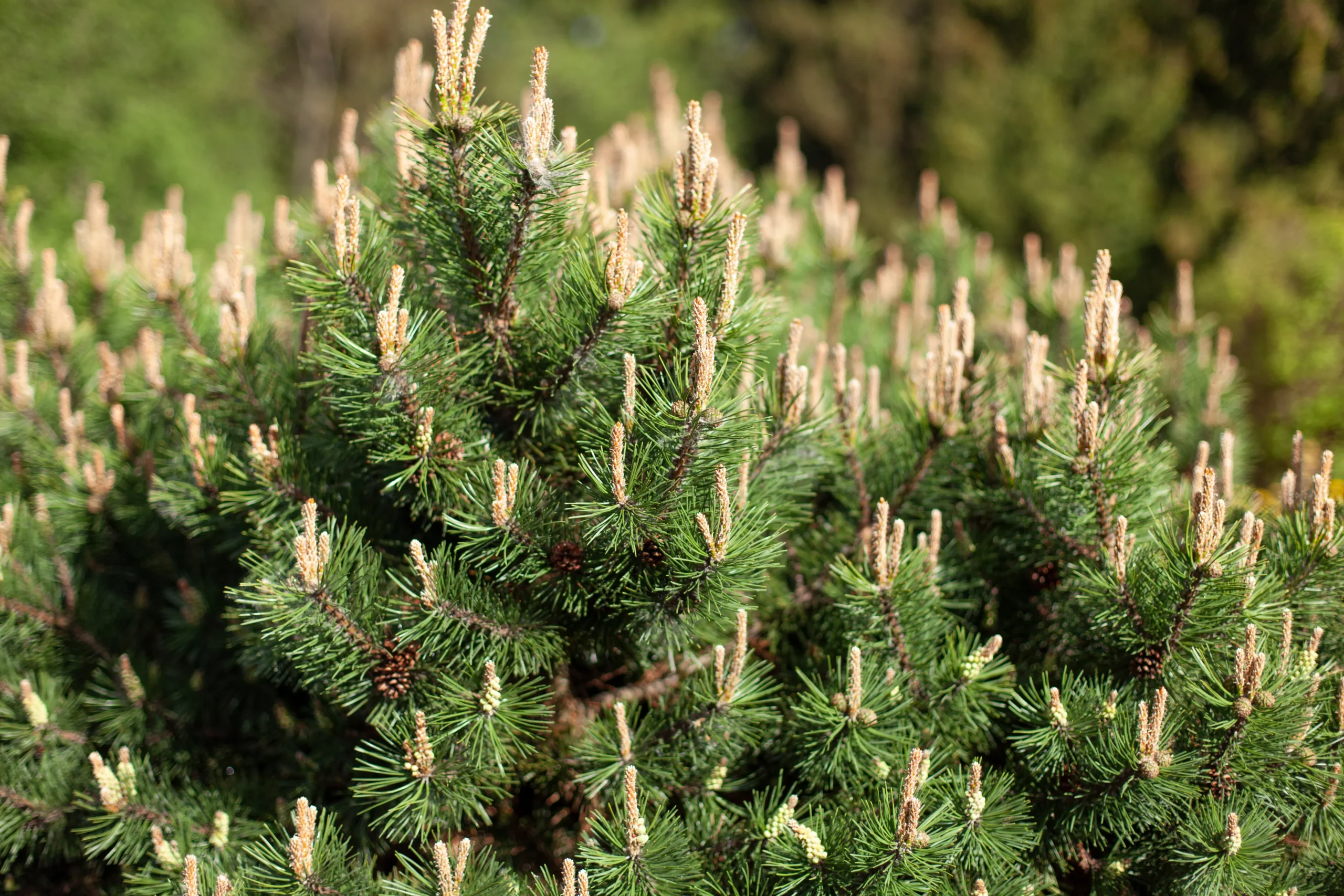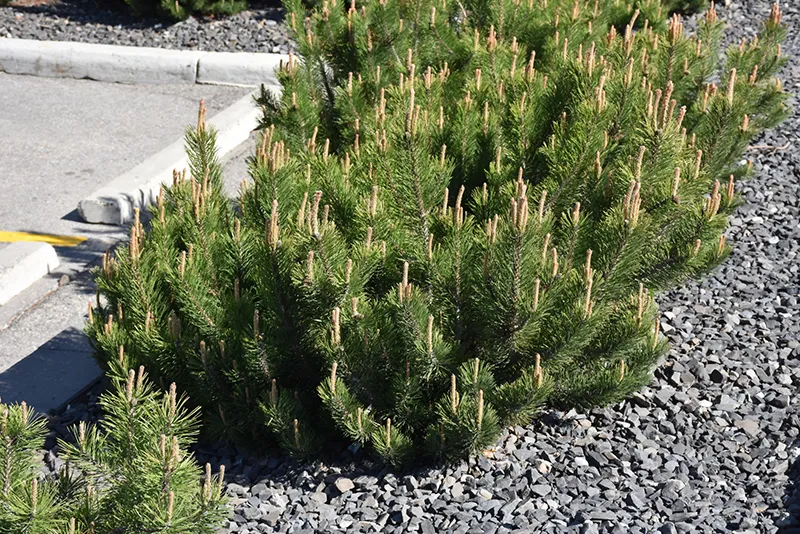Family: Pine
Type: Shrub
Other Common Name: Mugho Pine, Swiss Mountain Pine

The Dwarf Mugo Pine (Pinus mugo var. pumilio) is a versatile and hardy evergreen, perfect for adding year-round interest and texture to the garden. With its compact size and dense, dark green needles, it serves as an excellent ground cover or foundation plant, thriving in a range of conditions. Its slow growth and rugged nature make it a favorite among gardeners seeking low-maintenance landscape solutions.
This resilient dwarf pine is particularly suited for rock gardens, slopes, and border plantings, where its tough disposition can shine. It tolerates cold climates exceptionally well, making it a staple in northern gardens. Additionally, the Dwarf Mugo Pine’s tolerance of drought once established further enhances its appeal for use in water-conserving landscapes.
Not only does the Dwarf Mugo Pine offer aesthetic appeal with its richly colored needles and classic pine silhouette, but it also attracts wildlife, providing shelter for birds throughout the year. Its ability to adapt to various soil types, resist pests and diseases, and require minimal pruning contributes to its popularity in residential and commercial landscapes alike.
Hardiness Zone: 2b-7b
Pet Friendly: Yes
Moisture Preference: Dry to average
Sun Needs: Full Sun
Drought Tolerance (Xeriscape): Yes
Growth Rate: Slow
Average Height (feet): 7
Average Spread (feet): 9
Average Life Span (years): 50
Form: Round
Foliage Color: Green
Foliage Shape: Needle
Bark Color: Gray
Bark Texture: Rough
Incorporating Dwarf Mugo Pine into your yard introduces structure and texture. Its rounded shape and evergreen foliage provide a strong visual anchor in garden designs, contrasting beautifully with both deciduous plants and perennials. Planting it in groups can create a cohesive, low-maintenance underplanting that adds depth and interest to your outdoor space.
Pairing Dwarf Mugo Pine with flowering shrubs and ornamental grasses can enhance your garden’s aesthetic appeal. Its dark green needles serve as a stunning backdrop for vibrant flowers and soft grasses, creating a dynamic and varied landscape composition. This evergreen works well in both formal and informal settings, adding elegance or rustic charm as needed.
For those with limited space, Dwarf Mugo Pine is an excellent choice for container gardening. Its slow growth rate and adaptability make it ideal for pots or planters, where it can live comfortably for years with proper care. Whether used as a solitary specimen on a patio or as part of a mixed container display, it brings a touch of nature’s resilience to urban environments.

The Dwarf Mugo Pine thrives in rock gardens, where its compact form and tolerance for poor soils mimic alpine conditions. It adds structure and greenery, complementing the rugged beauty of stone and gravel.
In a Japanese garden, the Dwarf Mugo Pine can symbolize endurance and grace. Its form and texture align with the principles of balance and simplicity, making it a fitting choice for such tranquil spaces.
For coastal gardens challenged by strong winds and salty air, the Dwarf Mugo Pine is an ideal selection. Its hardiness and ability to withstand challenging conditions make it a survivor in seaside landscapes.
Use Dwarf Mugo Pine to edge walkways or driveways, where its uniform growth habit creates a neat, orderly appearance. This evergreen’s durability makes it suitable for defining spaces and guiding movement through the garden.
Incorporate Dwarf Mugo Pine into a wildlife-friendly garden design. Its dense branches offer shelter for birds, while its evergreen nature provides year-round interest and cover. Pairing it with berry-producing shrubs can create a haven for various wildlife.
Consider using Dwarf Mugo Pine as a natural ground cover on slopes or areas prone to erosion. Its root system helps stabilize the soil, while its low-growing nature minimizes maintenance in hard-to-reach places.
Select our pre-made garden layouts to create a landscape that’s uniquely yours. Simple, smart, and customizable!
In spring, the Dwarf Mugo Pine begins to push out new growth, with fresh, bright green tips emerging against the darker, mature needles. This contrast highlights the plant's vitality and growth, signaling the start of the garden's seasonal renewal.
During the summer, the Dwarf Mugo Pine remains a steadfast presence in the garden, its deep green needles providing a cool, calming effect amidst the riot of summer blooms and the heat of the season.
As fall colors sweep through the garden, the Dwarf Mugo Pine stands unchanged, offering a constant, evergreen presence. Its resilience against the cooling temperatures underscores its role as a garden anchor.
Winter showcases the Dwarf Mugo Pine's strength, as it remains green and vibrant against a backdrop of snow and bare branches. Its ability to add color and structure to the winter landscape makes it invaluable in year-round garden planning.
Ilex crenata Soft Touch
Polystichum munitum
Ophiopogon japonicus 'Nanus'
Dwarf Mugo Pine thrives in areas with full sun to partial shade. Choose a spot where the plant will receive at least 6 hours of sunlight daily for optimal growth and health.
Full sun is ideal for Dwarf Mugo Pine, promoting dense growth and the best overall health. However, it can also tolerate partial shade, especially in regions with very hot summers.
This pine prefers well-drained, sandy, or loamy soil but is adaptable to a wide range of soil types. It's tolerant of both acidic and alkaline pH levels, making it versatile for different garden environments.
Space Dwarf Mugo Pine plants approximately 3 to 5 feet apart. This allows enough room for growth while maintaining the plant's natural shape and ensuring adequate air circulation.
The best time to plant Dwarf Mugo Pine is in the spring or early fall. Cooler temperatures during these seasons help the plant establish roots without the stress of extreme heat or cold.
Dig a hole as deep and twice as wide as the root ball. Place the plant in the hole, ensuring it’s at the same depth it was in the pot. Backfill the hole, water thoroughly, and mulch around the base to retain moisture.
Water Dwarf Mugo Pine regularly during its first growing season to establish a deep root system. Once established, it’s drought-tolerant and requires watering only during prolonged dry spells.
Apply a balanced, slow-release fertilizer in early spring before new growth begins. Dwarf Mugo Pine does not require heavy feeding; moderate fertilization is sufficient.
Pruning is seldom needed. If desired, lightly prune in late winter or early spring to shape or remove any damaged branches. Avoid heavy pruning, as this can harm the plant.
Check for any winter damage and prune as needed. Apply a layer of mulch to conserve moisture and control weeds. Early spring is also the time to fertilize.
Monitor water needs during hot, dry periods. Dwarf Mugo Pine is drought-resistant but may benefit from occasional watering to keep the soil slightly moist.
Prepare the plant for winter by applying a fresh layer of mulch around its base. This helps protect the roots from freezing temperatures.
No specific care is needed in winter. Dwarf Mugo Pine is cold-hardy and can withstand winter conditions without special treatment.
Thuja 'Mr. Bowling Ball'
Pinus mugo 'Slowmound'
Thuja occidentalis 'Golden Globe'
Dwarf Mugo Pine is a slow-growing plant, typically adding about 3-5 inches in height and width per year. Its growth rate makes it ideal for small gardens and spaces.
Yes, Dwarf Mugo Pine is an excellent choice for bonsai due to its slow growth rate, compact size, and resilience. Its natural form and evergreen foliage make it a popular bonsai specimen.
While generally robust, Dwarf Mugo Pine can be susceptible to pine needle scale and sawfly larvae. Regular monitoring and prompt treatment can manage these issues effectively.
Sign up below to get exclusive deals, discounts, and new plant collections—delivered straight to your inbox! Plus, stay inspired with the latest gardening tips, landscaping trends, and DIY garden ideas. Start growing with us today!
A big thank you for subscribing to the PBN Design newsletter.
We're thrilled to have you join our community. Get ready for exciting updates, insightful content, and more delivered straight to your inbox.
Stay tuned!
Go backA big thank you for subscribing to the PBN Design newsletter.
We're thrilled to have you join our community. Get ready for exciting updates, insightful content, and more delivered straight to your inbox.
Stay tuned!
Go back